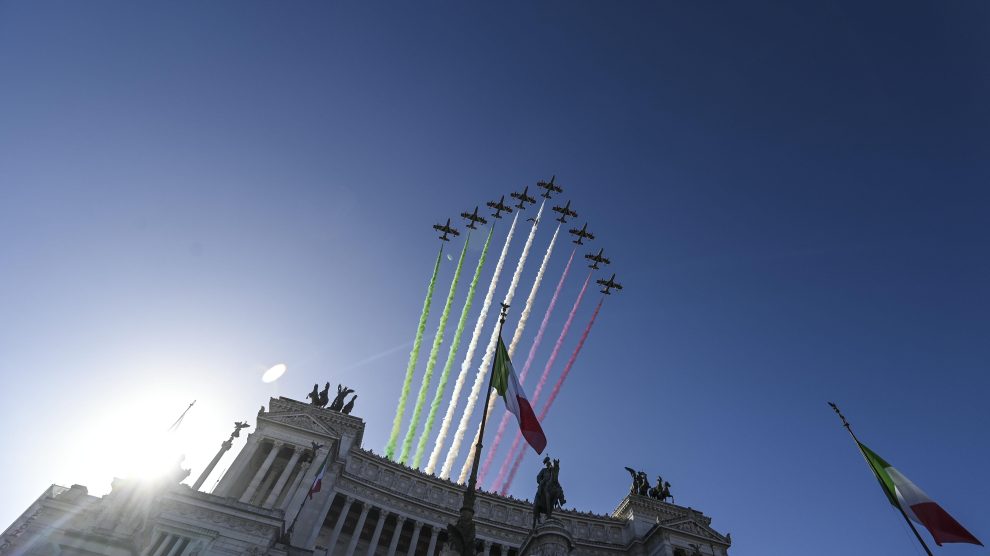A pillar of European security. Italy remains a cornerstone of Europe’s defence industrial base, excelling in sectors such as aerospace, electronics, and shipbuilding, according to Area Studi Mediobanca’s latest analysis of the industry.
- The report highlights the country’s highly diversified defence sector, structured as a pyramid with two state-controlled giants, Leonardo and Fincantieri, at the apex. These companies act as prime contractors in the most critical and high-value market segments.
- The second tier consists of mid-sized firms specializing in subsystems, while a network of small and medium-sized enterprises (SMEs) forms the broad base, showcasing Italy’s potential for innovation and excellence.
- Italy’s defence industry, driven by its dual-use capabilities and robust export focus, remains a vital component ofthe European security framework.
- With strong state backing, increasing investments, and a focus on innovation, the sector is poised for continued growth, despite challenges from global competition and economic pressures.
Key figures and performance. The top 100 Italian defence firms, each with revenues exceeding €19 million and more than 50 employees in 2023, generated an aggregated turnover of €40.7 billion last year.
- Of this, approximately 49% (€20 billion) is attributed directly to defence-related activities, marking a 6.6% increase from 2022 and a 14.7% rise compared to 2021.
- In terms of employment, these firms supported a total workforce of over 181,000, with around 54,000 roles directly tied to defence operations within Italy. The sector’s contribution to Italy’s GDP stands at 0.3%.
Sectoral strengths and export power. Aerospace and automotive accounted for nearly half (49%) of the total revenues, followed by shipbuilding at 23.3%.
- Leonardo and Fincantieri dominate the landscape, joined by only eight other firms surpassing €1 billion in revenue, collectively representing three-quarters of the industry’s total turnover.
- Italian defence firms are heavily export-oriented, with 68.2% of sales in 2023 stemming from foreign markets.
- Excluding Leonardo and Fincantieri, this share drops to 49.4%.
- Europe absorbs 61% of exports, followed by the Americas, driven mainly by U.S. demand (29%), and other regions (10%).
Ownership structure and foreign investment. State-controlled firms contribute 59.3% of the sector’s total revenues, underscoring the importance of public investment in the industry.
- Foreign groups control 36 of the top 100 companies, accounting for 25.1% of revenues, with European and U.S. entities holding 12.2% and 10.1%, respectively.
- Meanwhile, Italian family-owned SMEs, though more numerous, account for just 15.6% of revenues.
Investment, R&D, and profitability. Research and development spending averaged 6% of revenues in 2023, reflecting the industry’s focus on innovation.
- Profitability also improved, with EBIT margins rising from 5.7% in 2021 to 6.2% in 2023.
- Family-owned firms outperformed their peers with a 12.2% EBIT margin, attributed to their agile and flexible structures.
- Investments surged by 46.5% between 2021 and 2023, reaching 3.9% of total revenues last year. Family-owned firms again led the way, increasing investments by 71.9% during the period and achieving an intensity of 5.2% in 2023.
- The sector’s financial health improved, with debt-to-equity ratios declining from 70.2% in 2021 to 61.3% in 2023, while equity levels grew by 20.2%, significantly outpacing a 4.9% rise in debt.
- However, liquidity decreased slightly, from 47.2% of financial debt in 2021 to 42.7% in 2023.
Addressing challenges. On Monday, Defense Undersecretary Matteo Perego di Cremnago highlighted the critical challenges posed by emerging technologies.
- “We face a challenge of awareness,” Perego remarked at “The Defense Era” event, where the Mediobanca report on Italy’s defence industry was unveiled.
- He stressed that investing in defence is fundamental to strengthening national security, which in turnunderpins prosperity and development.
- Perego also pointed to the rising significance of dual-use technologies, which bridge civilian and military applications.
- These innovations, he noted, are attracting growing investor interest thanks to their ability to deliver industrial-scale solutions efficiently, cutting both costs and development times.
- His comments echoed key findings from the Mediobanca report, which underscores the sector’s focus on innovation and dual-use capabilities as drivers of growth.





